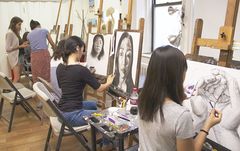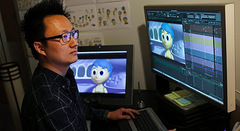Craft and fine artists typically do the following:
- Use techniques, such as knitting, weaving, glass blowing, painting, drawing, or sculpting
- Develop creative ideas or new methods for making art
- Create sketches, templates, or models to guide their work
- Select which materials to use on the basis of color, texture, strength, and other qualities
- Process materials, often by shaping, joining, or cutting
- Use visual elements, such as composition, color, space, and perspective, to produce desired artistic effects
- Develop portfolios highlighting their artistic styles and abilities to show to gallery owners and others interested in their work
- Display their work at auctions, galleries, museums and online marketplaces
Artists create objects that are beautiful, thought-provoking, and sometimes shocking. They often strive to communicate ideas or feelings through their art.
Craft artists work with many different materials, including ceramics, glass, textiles, wood, metal, and paper, to create unique pieces of art, such as pottery, quilts, stained glass, furniture, jewelry, and clothing. Many craft artists also use fine-art techniques—for example, painting, sketching, and printing—to add finishing touches to their products.
Fine artists typically display their work in museums, commercial or non-profit art galleries, corporate collections, on the Internet, and in private homes. Some of their artwork may be commissioned (requested by a client), but most is sold by the artist or through private art galleries or dealers. The gallery and the artist decide in advance how much of the sale proceeds each will keep.
Most craft and fine artists spend their time and effort selling their artwork to potential customers and building a reputation. However, only the most successful artists are able to support themselves solely through the sale of their works. Many artists have at least one other job to support their craft or art careers.
Some artists work in museums or art galleries as art directors or as archivists, curators, or museum workers, planning and setting up exhibits. Others teach craft or art classes or conduct workshops in schools or in their own studios. For more information on workers who teach art classes, see the profiles on kindergarten and elementary school teachers, middle school teachers, high school teachers, and postsecondary teachers.
Craft and fine artists specialize in one or more types of art. The following are examples of types of craft and fine artists:
Cartoonists draw political, advertising, comic, and sports cartoons. Some cartoonists work with others who create the idea or story and write captions. Some create plots and write captions themselves. Most cartoonists have comic, critical, or dramatic talents, in addition to drawing skills.
Ceramic artists shape, form, and mold artworks out of clay, often using a potter’s wheel and other tools. They glaze and fire pieces in kilns, which are special furnaces that dry and harden the clay.
Fiber artists use fabric, yarn, or other natural and synthetic fibers to weave, knit, crochet, or sew textile art. They may use a loom to weave fabric, needles to knit or crochet yarn, or a sewing machine to join pieces of fabric for quilts or other handicrafts.
Fine art painters paint landscapes, portraits, and other subjects in a variety of styles, ranging from realistic to abstract. They may use one or more media, such as watercolors, oil paints, or acrylics.
Furniture makers cut, sand, join, and finish wood and other materials to make handcrafted furniture. For more information about other workers who assemble wood furniture, see the profile on woodworkers.
Glass artists process glass in a variety of ways—such as by blowing, shaping, or joining it—to create artistic pieces. Specific processes used include glassblowing, lampworking, and stained glass. These workers also decorate glass objects, such as by etching or painting.
Illustrators create pictures for books, magazines, and other publications, and for commercial products, such as textiles, wrapping paper, stationery, greeting cards, and calendars. Increasingly, illustrators use computers in their work. They might draw in pen and pencil and then scan the image into a computer to be colored in, or use a special pen to draw images directly onto the computer.
Jewelry artists use metals, stones, beads, and other materials to make objects for personal adornment, such as earrings or necklaces. For more information about other workers who create jewelry, see the profile on jewelers and precious stone and metal workers.
Medical and scientific illustrators combine drawing skills with knowledge of biology or other sciences. Medical illustrators work with computers or with pen and paper to create images of human anatomy and surgical procedures, as well as three-dimensional models and animations. Scientific illustrators draw animal and plant life, atomic and molecular structures, and geologic and planetary formations. These illustrations are used in medical and scientific publications and in audiovisual presentations for teaching purposes. Some medical and scientific illustrators work for lawyers, producing exhibits for court cases.
Printmakers create images on a silk screen, woodblock, lithography stone, metal etching plate, or other types of matricies. The matrix is then inked and transferred to a piece of paper, using a printing press or hand press to create the final work of art. Workers who do photoengraving are called printing workers.
Sculptors design and shape three-dimensional works of art, either by molding and joining materials such as clay, glass, plastic, or metal, or by cutting and carving forms from a block of plaster, wood, or stone. Some sculptors combine various materials to create mixed-media installations. For example, some incorporate light, sound, and motion into their works.
Sketch artists, a particular type of illustrator, often create likenesses of subjects with pencil, charcoal, or pastels. Sketches are used by law enforcement agencies to help identify suspects, by the news media to show courtroom scenes, and by individual customers for their own enjoyment.
Video artists shoot and record experimental video that is typically shown on a loop in art galleries, museums, or performance spaces. These artists sometimes use multiple monitors or create unusual spaces for the video to be shown.






.jpg)





